The 10+ biggest things to happen in PPC so far in 2016
Big text ad changes, a revival of device bidding and LinkedIn possibilities are among the announcements that hold big implications for search marketers. Read more
Big text ad changes, a revival of device bidding and LinkedIn possibilities are among the announcements that hold big implications for search marketers. Read more
Marketing your business on the internet is different than any other type of marketing. There are dozens of concepts, technologies, terminologies, and rules to learn before you even get started. What’s more, the types of advertisements available to you are new and foreign to some that hasn’t been in the business for a hundred years.
A digital marketing agency that offers a full suite of services is the best way to go if you want to make sure you get the results you expect from your online marketing efforts. And if you don’t believe me, just wait.
Many digital marketing agencies specialize in only one product: delivering results for businesses. The tools, metrics, technologies, and terminologies that are so perplexing to you are the life blood of our business. They work to help you identify and then meet your performance goals, including leads, sales, customer acquisition, traffic, and customers.
These are the elements that help you define success for your business and they have deep product knowledge about how to achieve them on behalf of your business.
If you can find a company that offers customers the benefit of their own programmatic buying platform, you will be on your way to a success. This means that in addition to creating a strategy to help you achieve your goals, you will also enjoy the implementation of that strategy and the actual purchasing of advertisement views via our real time bidding platform.
In other words, a unique business structure will allow you to experience results oriented traffic generation, sales conversions, and more.
The Internet is constantly evolving. That’s a great thing for businesses that operate on the cutting edge of these new technologies. When you use a platform for purchasing display advertising, you also have the ability to immediately change bids, adjust strategies, split test, and adjust ad buys on the go – in real time. This gives you the distinct advantage of seeing what is and isn’t working as you go and changing your ad buys to more effective advertisements that are reaching your target audience. It gives you a very real advantage of competitors who have not yet embraced this technology.
Simply put, a digital marketing agency helps you get bigger, better, and faster results from your advertising dollars. They do this by sharing the value of their expertise, the ease of their system, and the technology that brings these things together for even more effective marketing.
We are a Chicago based Digital Marketing & Consulting firm. Our digital marketing strategies increase your online reach, strengthen your brand equity, help achieve stronger business results and generate greater profitability.
Our approach is based around working with your company on an ongoing basis to adapt and stay ahead of your competition in an ever-changing digital marketplace. We combine experienced talent with world-class technologies to efficiently create digital marketing programs that truly perform.
Digital Marketing across multiple platforms allows us to create visibility for your company in the places your customers are searching, interacting and engaging on the internet.
Onimod Global is an official Google Partner. The Google Partner badge means that Google trusts our agency. It also shows our clients are happy and that we follow Google best practices.
Digital Synergy is about having visibility in the places your consumer needs you. Every search request is an opportunity; each action on a social site is an opportunity. Having the correct brand, product or service positioning is essential.
Our cross-channel digital marketing expertise, data analysis, precise construction and execution of successful digital marketing campaigns make sure your brand meets the consumer when and where they need them.
Every company has a myriad of unique factors; yours included. Learning a company’s core attributes, processes and initiatives allows us to create dynamic data driven digital marketing solutions that offer marked returns. Contact us today to find out more.
SEO, SEM, Social, Email, Website, User Behavior, Analysis, Testing, Programming, Reporting. Synergy. Onimod Global.

The last several days were full of intriguing and surprising data points from the world of digital marketing.
Below appear 9 numbers that caught our eye:
1. Quietly killing it on Facebook
Whisper, which has nearly 2.3 million fans on Facebook, regularly garners between 10,000 likes and 40,000 likes for posts on the social site, a rep for the anonymity app said. For instance, click here to see how one of its confessional-styled memes got big engagement on Thursday.
The company, located in Venice, Calif., doesn’t buy ads to get such results—all the action is organic. Look for an upcoming Adweek story about how Whisper’s tech team has mastered Facebook’s algorithm.
2. Messenger added 100 million users in last three months
Facebook Messenger now has 900 million monthly users, up from 800 million in January, according to Facebook.
3. Kendall’s social kingdom
Influencer.DB, an Instagram analytics firm, said that reality TV star and social media juggernaut Kendall Jenner gains nearly 100,000 followers a day on Instagram. Interestingly, she does best in Germany, which is home to 21 percent of her followers, Influencer.DB said. Meanwhile, the tech vendor also stated that just 7 percent of Jenner’s Instagram followers are in the United States.
4. Insta-hot rod
Mercedes-Benz has been kicking its Instagram game into fifth gear in recent months. For instance, the post below—seen on the car brand’s global account—on Thursday attracted 74,000 likes in its first three hours. And that’s relatively normal for the marketer.
5. A social commerce close-up
In the last three months, e-commerce vendor Custora crunched data about $100 billion in sales among 500 million shoppers and found that only 1.5 percent of retailers’ last-click e-commerce transactions came via social media. Within that sliver of activity, Facebook dominated 81 percent of sales, while shopping-centric Pinterest generated 10.8 percent and Instagram, YouTube and Twitter collectively yielded 5.2 percent.
6. Ad fraud problems
DataXu’s new report said that the rate of fraudulent digital ads fall anywhere in between 17 percent and 30 percent on networks and exchanges. That declaration follows up a joint study by the Association of National Advertisers and White Ops in January that predicted digital ad fraud would cost the industry $7.2 billion this year.
7. Marketers signal confidence
The Economist Intelligence Unit, a research division for The Economist, and software giant Marketo teamed for a new study, which revealed that 86 percent of marketers believe they will own the end-to-end customer experience by 2020.
8. Email laziness
According to a study by digital marketing company Adestra, 80 percent of consumers unsubscribe from emails they no longer want to get. Here’s another way of looking at it: A good chunk of folks (20 percent) are too lazy—or busy, to be fair—to take themselves off a list.
9. The search for March Madness
Per tech company HookLogic, basketball-based online searches via its network of e-commerce websites, including Walmart, Target, Sears and Kohl’s, jumped 35 percent during the heart of March Madness this year, compared to the days before the NCAA tourney began.
Bonus stat: Taylor-made power
On April 1, pop songstress Taylor Swift posted a funny spot for Apple on her social accounts, showing her working out. Last weekend, iTunes sales of the song featured in the ad, Drake’s “Jumpman,” skyrocketed 431 percent globally. On Instagram alone, the 1-minute clip has received 1.4 million likes and 153,000 comments.
The digital marketing world is ever fluid, always dynamic and never dull, especially to the ever growing need to grow that CMO constantly faces. This is in part due to the emergence of new trends that are fundamentally changing the way marketers and brands reach out to potential customers. This changing landscape is essentially urging all players to step outside their comfort zone in order to attract high quality leads.
Outside of their comfort zone, traditional digital marketers are faced with a series of challenging tasks. From understanding the need to market across cross-platform devices and channels, to running customer-segmentation based messaging campaigns, these and other digital marketing trends are defining the future of marketing.
While there are plenty of growth hacking techniques available to CMOs and other marketing leaders, it might make sense to rely on an occasional helping hand.
Indeed, to help make sense of marketing trends and to capitalize on what they may mean for your business, consider hiring a third-party digital marketing agency to meet the demands and deadlines of your digital marketing to-do list.
But why would a CMO need to use an external digital marketing agency? The following points should give you some insights.
1. Stay Industry-Relevant
For starters, digital marketing agencies must follow the latest developments across digital marketing trends on a regular basis. It is part of their job description. If certain agencies fail to grasp what is happening, changing or unfolding in their industry, they will cease to be relevant. This is especially important, as current digital trends indicate that effective marketing requires brands to reach their target audience while adopting advanced omnichannel strategies. While your eye is understandably on your company and the product, digital marketing agencies are committed to keeping you abreast of all the latest developments in marketing.
2. Better Industry Storytellers
While your marketing team may be working really hard to promote your product offering, digital marketing agencies are made up of experienced professionals that can provide tangible value in defining and spreading your brand’s appeal across leading industry players. This focus can help bring about real results that can be very beneficial to your company. For instance, if your chosen agency succeeds in creatively generating positive PR about your brand’s ability to meet trend-related demands, this will improve your company’s image and naturally, help you capitalize on many marketing opportunities.
Unless you have a massive overhead budget, it’s almost impossible to hire effectively the skillsets needed to capitalize on many digital marketing opportunities. The capable talent to execute the digital strategies is an inherent part of agency culture, one that needs to be stimulated by daily deep, creative exercises. Also, today in the competitive digital landscape, brands need to limit risk, reduce human resource efforts, and purchase results by an accountable agency.
Learn more about who we are and what our Digital Marketing experts can do for you today.
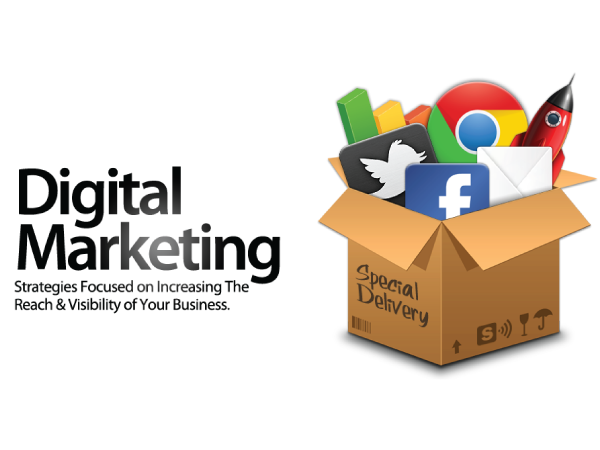
It’s been a notable week for digital marketing stats, with new studies, developing news and industry trends. Here are the seven items that caught our eye:
1. Apple is winning against the FBI in the court of public opinion
The Apple-FBI dustup this week has struck a nerve with many people because it represents an unusual confluence of a popular consumer brand, privacy and terrorism. Apple CEO Tim Cook rejected a court order to disable the iPhone’s auto-erase function, which removes all data from the device after 10 failed attempts to break into it. The feds’ demand was related to a phone belonging to Syed Rizwan Farook, the San Bernardino, Calif., shooter who gunned down 14 people on Dec. 2.
Some saw it as a risky branding move on the part of Cook and Apple, but when Vrge Analytics surveyed 600 people on Feb. 18 and 19, it found that 65 percent don’t believe Apple should be forced to unlock the shooter’s iPhone.
2. Advertisers are still lukewarm on podcasts
Advertisers are expected to spend $35.1 million on podcasts this year, says media agency ZenithOptimedia in The Wall Street Journal. Even though the format has exploded since Serial took off a little over a year ago, that figure represents just a 2 percent year-over-year increase.
3. City of the future
CityBridge plans to install at least 7,500 of its LinkNYC smart kiosks (and possibly as many as 10,000) around New York in the next few years, making Gotham one of the largest digital out-of-home networks in the world. Brands will be able to leverage the network with ads and interactive bells and whistles.
4. Is Periscope the key to your next gig?
Tim Menko and Ingmar Larsen are 30-year-old ad creatives in Amsterdam looking for full-time gigs in their adopted hometown as well as freelance work around the world. So earlier this week, they turned to livestreaming app Periscope to drum up interest in their talents. They reached their target audience—according to the duo, more than 100 people tuned in to the live presentation on their Periscope account (@MenkoLarsen) during the 35-minute presentation, with another 20 watching the replay during the 24 hours Periscope leaves clips online after the fact.
“It went really well,” said Menko “We got some great responses and are visiting three agencies in Amsterdam. Plus, a recruiter in London says he has got something for us, and we have scheduled in a Skype meeting [fusion_builder_container hundred_percent=”yes” overflow=”visible”][fusion_builder_row][fusion_builder_column type=”1_1″ background_position=”left top” background_color=”” border_size=”” border_color=”” border_style=”solid” spacing=”yes” background_image=”” background_repeat=”no-repeat” padding=”” margin_top=”0px” margin_bottom=”0px” class=”” id=”” animation_type=”” animation_speed=”0.3″ animation_direction=”left” hide_on_mobile=”no” center_content=”no” min_height=”none”][with him]. There was even an agency in Cape Town that would like to collaborate with us.”
5. Mobile commerce continues to soar
Bizrate, a division of Connexity, asked 9,142 online buyers in the U.S. and Canada about their device habits and learned that 73 percent use their smartphones to shop and that 21 percent use them to shop when they’re actually inside brick-and-mortar stores.
6. Latinos shop more on their smartphones
Hispanic shoppers are 36 percent more likely than non-Hispanics to use mobile devices to access digital shopping tools, per Epsilon’s recent survey of 2,500 consumers.
7. Danica reps Lyft
Lyft had Nascar star Danica Patrick pose as a driver for the ride-sharing service in a prank-style video, and it’s turned out to be a nice win for the brand. The clip, which you can watch below, has nearly 467,000 views in the past 30 hours on YouTube and Facebook.
[/fusion_builder_column][/fusion_builder_row][/fusion_builder_container]
Digital marketing is something every company has to give due consideration to. Not an online business you say. Too bad because that doesn’t excuse you from anything. Even local, land-based businesses have to focus on the online arena, as that’s where their target audiences are.
Here are seven things about digital marketing you absolutely have to know.
1. Mobile Is Now
Audiences aren’t shifting more to browsing via mobile devices. They are already there. Over 50% of all Internet users are now operating exclusively on mobile devices. If you haven’t made your site responsive and geared everything towards smaller screens, you’re in trouble. First, Google will actively penalize you in the search results, consequently reducing your audience. Second, your existing customers will become increasingly frustrated and alienated.
2. Micro-Moments
The easiest way to define this is by relating it to impulse shopping. Portability and accessibility in the business world has led to the rise of micro-moments. You have mere seconds to fulfill a customer’s need. Your company has to have a platform that operates 24/7 in order to cater to anyone wherever they are.
3. Using Apps
Apps are becoming the ultimate way to reach your audience. A quick look at the TV and you will see just how many companies are advertising their apps instead of their core businesses. This is because many customers are ignoring browsers and going straight for apps. If you don’t already have a related app for your business, now is the time to address that.
4. Consider The Internet Of Things
The Internet of Things is a modern phenomenon relating to how ordinary every-day objects can, and are expected to, connect with a network. In other words, our phones turned from a simple way to make calls to connecting to the Internet. Smart home technology is another example of how the Internet of Things is taking hold. This is yet to become an absolute ‘must’ for businesses as it’s still in its infancy, but you should already be considering what you’re going to do about it. For now, this may be as simple as an app or thinking about the wider impact of your products and services.
5. Branding and Brand Management
The definition of branding for digital marketers has changed. It once referred to printing business cards, coming up with a website, and slapping a logo on it. Your brand extends to everything, now, especially how you are going to communicate with customers. Branding for businesses in 2016 must be holistic. It must include delving into potentially difficult topics like reputation and crisis management. Brands that succeed in the long run plan for every possible eventuality. All it takes is a co-worker to say the wrong thing and it can completely smear the company’s reputation.
6. Pushing People Through The Door
According to Edward James, CEO of Go Up, “SEO was once measured by the amount of traffic flowing to a website. Digital marketers made their money through getting people through the door. What happened afterwards was none of their concern. Now the responsibilities of the digital marketer have changed. It’s less about pushing people through the door and more about monitoring them throughout the entire purchasing process.” The digital marketer must concentrate on all steps of the buying process. In addition, after that they have to think about how they are going to retain customers in the long-term.
7. Live Streaming
Live streaming through platforms like Periscope and Twitch are on the up. Many companies have dismissed them as novelties that don’t need to be considered. Nevertheless, digital marketers have managed to turn them into dollar signs. Don’t underestimate the desire of customers to see what’s going on inside an operation. While we can’t give you any concrete tactics for how to utilize live streaming for the benefit of your business, what we can say is this is something to watch. Digital marketing is set to become more interactive than ever before, and part of this revolution will come from harnessing the potential of live streaming.
Conclusion
Digital marketing isn’t something you can ignore if you want to make your organization into a success. The time is now to take advantage of it. If you don’t know enough about it, hire someone. Nevertheless, whatever you do don’t let your competitors pass you by.
Our cross-channel digital marketing expertise, data analysis, precise construction and execution of successful digital marketing campaigns make sure your brand meets the consumer when and where they need them. Contact us to speak with a Digital Marketing expert today.

Google has spoken — and an important part of the mobile web will never be the same. At least that’s the theory, and certainly the search giant’s intention.
Google sees app install interstitials — those big ads that pop up suddenly on the mobile web and monopolize all of your mobile device screen to prompt you to download an app, rather than let you keep surfing — as too annoying to users. On November 2, the company therefore put in place a new policy to discourage the ads.
According to this policy, Google has since penalized mobile websites that use such interstitials by declaring these websites mobile-unfriendly. According to Google’s more detailed blog post about the policy from September:
Mobile web pages that show an app install interstitial that hides a significant amount of content on the transition from the search result page will no longer be considered mobile-friendly. This does not affect other types of interstitials. As an alternative to app install interstitials, browsers provide ways to promote an app that are more user-friendly.

Graphic of an app install interstitial ad by Google.
Here at Yozio, my employer, we specialize in growing mobile apps through organic channels. We also considered app install interstitials a very viable option to drive downloads prior to the new policy going into effect. Hence, we’ve been watching its effects closely.
Now that the policy has been in place for a couple of months, we wanted to explore some basic questions: Has Google’s decision actually affected how mobile websites attempt to drive visitors to download apps? And how have some of the most prominent and growth-hacking savvy companies dealt with the change?
To answer those questions, let’s start by understanding the real context for Google’s sudden change — and why app install interstitials may not be that bad after all.
Google published the results of an experiment on the effects of interstitials on one of its own mobile websites, Google+, earlier this year. In this study, Google compared the results of showing visitors to the Google+ mobile website an app install interstitial with the results of showing them a smaller and less intrusive app install banner.
When showing the banner, Google reported that the number of people installing the Google+ app stayed virtually the same compared to showing the interstitial, while the number of one-day active users on the mobile website actually increased by 17 percent.
Although Google did not mention this study in its announcement of the policy, it’s reasonable to assume that such a directly relevant experiment is related to the company’s decision.
However, the results of the study may not be as clear-cut as they seem at first glance, and Google’s case against interstitials not as simple as it appears.
First, this was but one experiment, by one company, for one kind of mobile website and app. Across Yozio’s customers, we’ve seen some who increased installs significantly through optimizing interstitials: by 100 percent for Pinterest and 300 percent for Airbnb, for example.
For other customers of ours, interstitials were much less important. This experience suggests Google should not necessarily draw conclusions from just one test for one app.
Second, the experiment involved an app that Google doesn’t seem to care about: As the post about the study mentions, Google since retired both the interstitial and the banner permanently, preferring to leave users on the Google+ mobile web pages.
Third, if you’re not using one of Google’s apps (or at least an app featuring Google’s advertising), it’s clearly in the search giant’s interest to keep you on the mobile web instead — where you can access its search engine and see its ads much more easily.
It turns out that app interstitials may not be that bad, then, and Google’s reasons for opposing them not that simple. And what if your app does actually offer a better experience for users than your mobile website?
Let’s look at how some of the best companies that now comply with Google’s policy — and still find ways to drive traffic to their mobile app.
One of the most innovative ways to circumvent Google’s new policy comes from — you guessed it — Google itself. This time, it’s for Google Docs, an app that’s decidedly better than its equivalent mobile web experience, and probably more valuable for more users than Google+.
What mobile users see when they arrive on the Google Docs site looks almost exactly like an interstitial, but it isn’t one. It’s the web page itself, only made to look like an interstitial. The navigation menu in the top right corner gives it away.

This is how Google survives its own policy.
Yelp uses a similar strategy. No longer able to use a separate interstitial, Yelp (not affiliated with Yozio) simply made a mobile web page that looks exactly like one.
In fact, the page looks so much like an interstitial that we ran it through Google’s mobile-friendly test — and it passed with flying colors.

This mobile web page from Yelp looks like an interstitial.
LinkedIn (again, no affiliation with Yozio) uses an equally innovative, but somewhat more sophisticated, approach. While the mobile web version of LinkedIn’s site does not use interstitials, when you request LinkedIn.com in your mobile browser, you’re instead redirected to a new, separate mobile web page. And this does look like an interstitial.
Cleverly, however, LinkedIn has excluded this new web page from Google’s indexing. So therefore, Google can’t penalize LinkedIn for using it, either.

LinkedIn’s special web page cannot be indexed by Google.
Google recommends using App Install Smart Banners in Safari or Native App Install Banners in Chrome to replace interstitials. Unfortunately, these don’t offer much flexibility in design, which makes them a bad alternative for growth teams who need to experiment and iterate. The ability to do that is non-negotiable because it’s by far the best way to increase users, engagement and conversions.
Airbnb (a Yozio customer) is a growth-savvy company and currently experimenting with its own banners as opposed to the ones recommended by Google. We checked — and Airbnb’s site is still mobile-friendly.
It seems Google has left some wriggle room for the experimenters after all.

Airbnb flouts Google’s recommendation by using a homemade banner.
Beware of making those banners too large, though. We found an example on Zappos’ mobile web pages that ran into trouble in Google’s mobile-friendly test, which stated that the page “appears to have an app install interstitial” and “may not be mobile-friendly.” (Yozio is not affiliated with Zappos.)

Zappos runs into trouble with its workaround.
We’ve seen our customers drive tens of millions of installs through organic channels such as mobile websites using app install interstitials or banners. Both can work — it all depends on the user.
Ultimately, understanding the user’s intent and presenting her with personalized content determines the click-through rate and install conversion rate. As Marketing Land editor Danny Sullivan’s excellent overview of Google’s policy explains, the company is ironically declaring war on the same problem it helped to create when it first started to drive users to download apps on its own sites.
By implementing this wide-ranging policy on the basis of questionable evidence, we don’t believe Google is putting the user first this time.
The move is now official: Bing has taken over serving search results and ads for AOL from Google. Initially announced in June 2015, the 10-year deal affects all AOL search traffic worldwide and on all devices. Here’s a look at what the move means for those managing Bing Ads campaigns.
First, the Ad distribution section under Ad Group level settings now includes AOL along with Bing and Yahoo.
You can now also change ad group level network distribution within Bing Ads Editor. Whatever your settings are now, they won’t change, other than the fact that AOL is now included.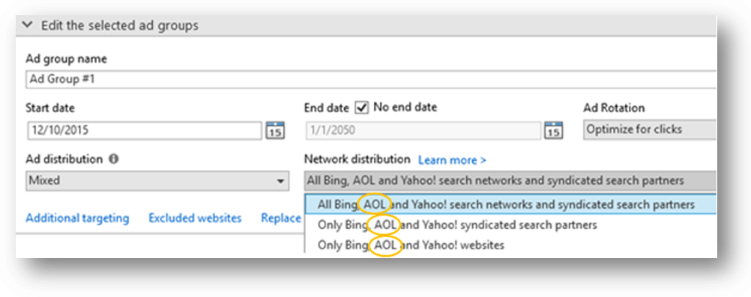
Bringing AOL into the fold also includes AOL’s syndicated search partners in relevant locations. You’ll have insights into this type of traffic that wasn’t available when AOL ads were served by Google. In the Website URL (Publisher) report, the URLs of AOL owned and operated websites will be shown on separate lines and not consolidated with Bing and Yahoo’s owned and operated websites listed under “Bing and Yahoo! Search Properties Only.” You might not necessarily know that the site is part of the AOL syndication, but you will be able to add individual sites to exclusionlists.
AOL search also now appears as a new value in the Network and Top vs. Other columns in reports (including those run from the Reporting API), such as the Keyword performance report and Campaign performance report, and AOL is listed with Bing and Yahoo syndicated search partners.
AOL traffic now factors into both Bing Ads Campaign and Keyword Planners, as well. For more details, see the Bing Ads blog post on the updates.

When the Hawkeyes played in the Rose Bowl in 1986, the first “laptop” computers weighed 12 pounds, the QVC network was new and the World Wide Web was still three years away.
Fast-forward to the wired age of 2015 and it’s a whole new world. With our noses glued to our ever-present screens and our attention splintered in a thousand different directions, collective events such as the Rose Bowl become a huge opportunity for connecting with customers on a personal level.
So businesses of all kinds are jumping on the Rose Bowl bandwagon with tools and tactics that weren’t even on the radar back then. For example, the University of Iowa’s athletic department proudly announced that it doubled its loyalty program’s membership for the mobile app, Hawkeye Rewards, after this year’s perfect regular season.
Travel agencies had their social media posts and ads prepped and ready to launch within minutes of the announcement.
Even businesses with only a glancing relationship with football were congratulating the team on their Facebook pages, creating Rose Bowl-themed specials, and tweeting their prognostications for the big game.
Marketing Micro Events
Most events won’t generate the kind of hype that a trip to the Rose Bowl does, but smaller, local events can be a good opportunity to promote your business and create community. A pizza joint near a high school can geo-target on hungry smartphone toting fans looking for a bite to eat after the game or event with coupons and deals.
Employers with positions to fill easily can target job fairs, industry events and even competitors. Businesses that hold seminars or trade shows can promote their events on LinkedIn and Facebook or through targeted behavioral ads.
Many of these tools allow granular targeting to the level of employer and even job title.
Events also can be a great source of content for future marketing campaigns. Businesses can create videos, slide shares or webinars and use those assets to acquire even more prospects and leads.
Targeting is Not a Penalty
Unlike the big game, targeting is practically a necessity in digital advertising because it helps you hit the audience most interested in your messages. Bonus: Nobody gets hurt and there’s no penalty.
Most people now expect businesses to anticipate, or at least recognize, their preferences and interests. For Iowa fans looking for tickets to the Rose Bowl, the more information they could find, the better.
Marketing analytics can identify which consumers followed the team page, visited related websites, purchased team apparel or mentioned their favorite teams on social media. The same methods are applied to identify customers with an interest in specific topics, products and services so you can provide relevant information and content to the right people.
Here’s one cautionary note: Don’t get cute. Consumers react badly to clickbait headlines such as “Rose Bowl Canceled” only to be taken to a page selling them something totally irrelevant. Not only will you not make the sale, you’ll likely lose whatever cyber trust you ever had with your audience to begin with.
In the meantime, enjoy the big game and good luck finding that coveted Rose Bowl apparel this year. Happy New Year and Go Hawks!
‘Tis the season for digital numbers that give folks an idea of what’s about to happen during the holidays. Check out six we found particularly interesting:
1. According to Salesforce Social Studio, Black Friday social conversations—via Twitter, Facebook, YouTube, blogs, etc.—are up 20 percent over last year.
2. DataRank, part of Simply Measured, pulled 77,000 #BlackFriday tweets from Nov. 1 through Nov. 22. In its study, the company examined positive sentiment versus negative sentiment around the hashtag and found the following:
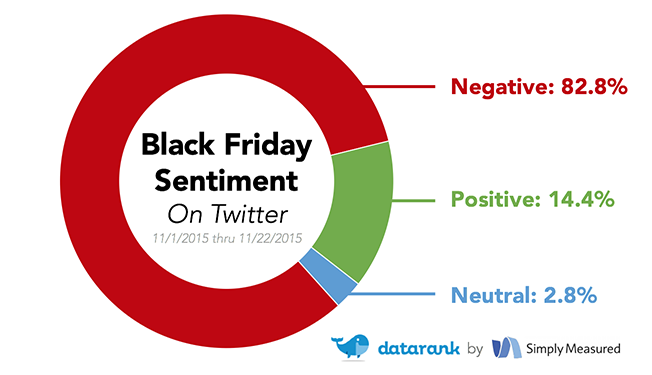
3. Walmart has appeared in 38 percent of the tweets about retailers, DataRank said, which made the big-box player No. 1 in that regard. Best Buy was second, appearing in 26 percent of such Twitter messages, while Target drew 23 percent. Here’s a full look at DataRank’s merchants-based findings:
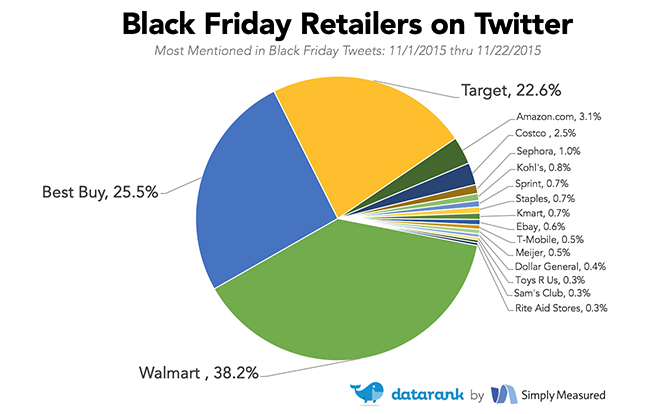
4. Millennials will spend on average $352 on holiday shopping this season, per Ypulse, which surveyed 1,000 Gen Y consumers. Their primary gift-giving recipient will be dear ole Mom (84 percent of the time).
5. According to November research from AYTM Market Research, 47 percent of U.S. Internet users said holiday promotions before Nov. 4 were effective in getting them to make purchases. Twenty-five percent “somewhat agreed” that such promos worked, while 29 percent disagreed that the ads were effective.
6. Researcher eMarketer projects a nearly 6 percent gain in retail holiday sales this year, with e-commerce continuing to grow in the double digits.
Non-holidays bonus stat: Monetate analyzed 7 billion online shopping experiences in the third quarter and found that social networks’ conversion rates came in at 1.3 percent, representing a slight lift year over year.
Call Us: 888-263-7046
159 N. Sangamon St.
Suite 200
Chicago, IL 60607
